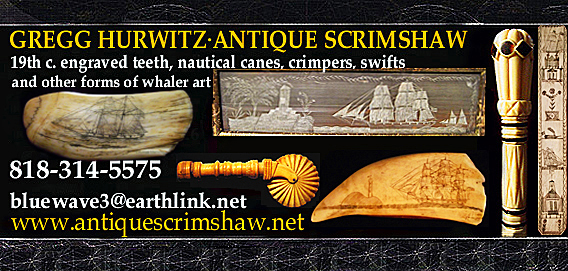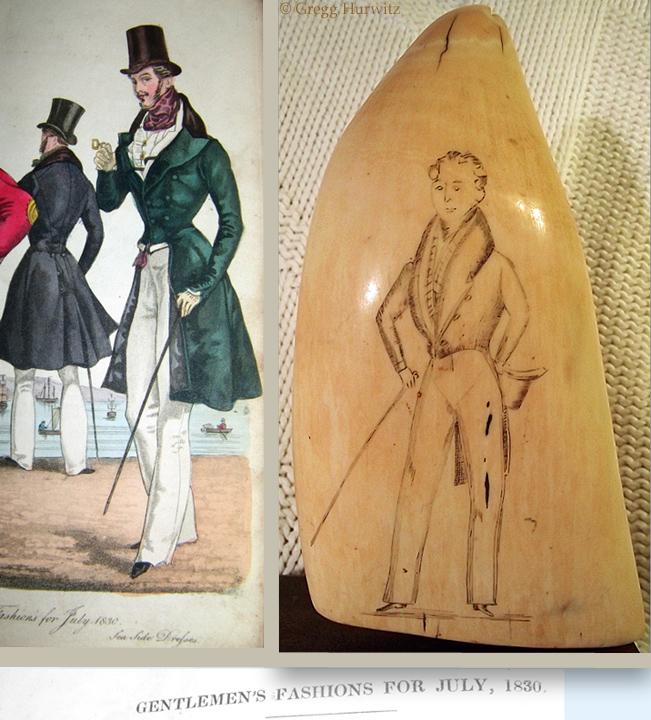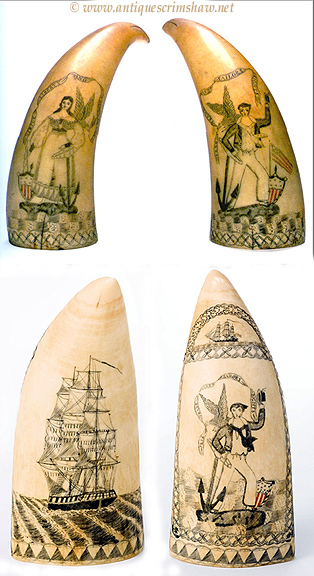

Whaling voyages averaged nearly four years.
To relieve the boredom of long periods of time
between whale sightings, whalemen often played cards,
checkers, and wrote in personal journals.
Those with an artistic bent did woodcarving,
sketching, knotwork, and made scrimshaw.
The taking of a whale provided scrimshanders with plenty of material.
Sperm whales provided teeth; all whales provided bone;
bowhead and right whales provided baleen, a black, flexible material
found in the mouths of these whales. Walrus tusks were also
decorated by whalers who ventured into Northern waters.
The quality of scrimshaw ranges from
crude scratchings on teeth or bone
to exquisite examples of fine craftsmanship
with the majority falling somewhere in between.
 SCRIMSHAW GALLERY
SCRIMSHAW GALLERY













architecturally carved crimpers by the same hand, see Flayderman, pg. 148


More on Pie Crimpers
MV Museum
********
1871 Arctic Whaling Disaster
The Whaling Disaster of 1871 was an incident off the northern Alaskan coast in which a fleet of 40 American whaling ships were trapped in the Arctic ice in late 1871 and subsequently abandoned. It dealt a serious blow to the American whaling industry, already in decline. Thirty-three whaleships were lost as ice closed in around them before they could sail south at summer's end. Twenty-two of the ships were from New Bedford and represented a loss of $1,600,000 (approximately $30,311,989 in 2011 dollars). All 1,219 people aboard the ships evacuated in small whaleboats with a three-month supply of provisions, crossed 70 miles (110 km) of ocean, and were eventually brought to safety by the seven ships which had escaped the ice to the south. Amazingly, there were no casualties. The names of the vessels lost in the 1871 disaster were:
Bark Roman of New Bedford
Bark Concordia of New Bedford
Ship Gay Head of New Bedford
Bark George of New Bedford
Ship John Wells of New Bedford
Bark Massachusetts of New Bedford
Bark J.D. Thompson of New London, CT
Ship Contest of New Bedford
Bark Emily Morgan of New Bedford
Ship Champion of Edgartown, MA
Bark Henry Taber of New Bedford
Bark Elizabeth Swift of New Bedford
Ship Florida of New Bedford
Bark Oliver Crocker of New Bedford
Bark Navy of New Bedford
Ship Reindeer of New Bedford
Bark Seneca of New Bedford
Bark George Howland of New Bedford
Bark Fanny of New Bedford
Bark Carlotta of San Francisco, CA
Bark Paiea of Honolulu
Bark Monticello of New London, CT
Brig Kohola of Honolulu
Bark Eugenia of New Bedford
Ship Julian of Honolulu
Bark Awashonks of New Bedford
Bark Thomas Dickason of New Bedford
Bark Minerva of New Bedford
Ship William Rotch of New Bedford
Brig Victoria of San Francisco, CA
Ship Mary of Edgartown
Brig Comet of Honolulu
Virtually every item aboard ship, every possession that was not 100% essential to human survival
was abandoned and left behind on the doomed whaleships.
This nearly 8 inch long, solid walrus ivory pie crimper is an
exceedingly rare artifact that survived and now commemorates that event.




























Although it is most often associated with the Yankee whale-men of the 19th century
the scrimshanders art was embraced and extensively practiced by
the British, Australian and Portuguese mariners as well.


















































































The name for a whale's tooth, tabua, is the same throughout the Fiji Islands, originally meant 'sacred object'. Fijians have no traditions of whaling, so it seems that tabua first came from stranded whales, either in Fiji, or in nearby Tonga. Tongans used the relative abundance of sperm whales in their waters to great advantage, bartering tabua for Fijian products as diverse as sandalwood and enormous voyaging canoes, a trade that lasted well into the nineteenth century.
The incidence of whaling ships in the Pacific during the nineteenth century caused a larger supply of whale teeth to become available. At first these were introduced into Fiji by Tongans who had a better access to them, but later, early 19th century European & American whaling ships brought sperm whale teeth as highly valued trade items. Tabua were the price of life and death and indispensable adjuncts to every proposal, whether for marriage, alliance, intrigue, request, apology, appeal to the gods or sympathy with the bereaved.
The traditional Fijian manner of preparing a whale's tooth was to stain and/or smoke it to give it the highly esteemed rich color then drill a small hole at either end and attach cord of braided coconut fiber or pandanus leaves. Occasionally some teeth were polished first. Often though, they were left in their raw, un-polished state prior to staining/smoking. After being thus prepared, it was then suitable for use in formal ceremonies of welcome, funeral gatherings, requests for marriage or land, formal apologies, installation of a chief and so on. When being presented or accepted, it is held in one hand with its cord in the other.


















